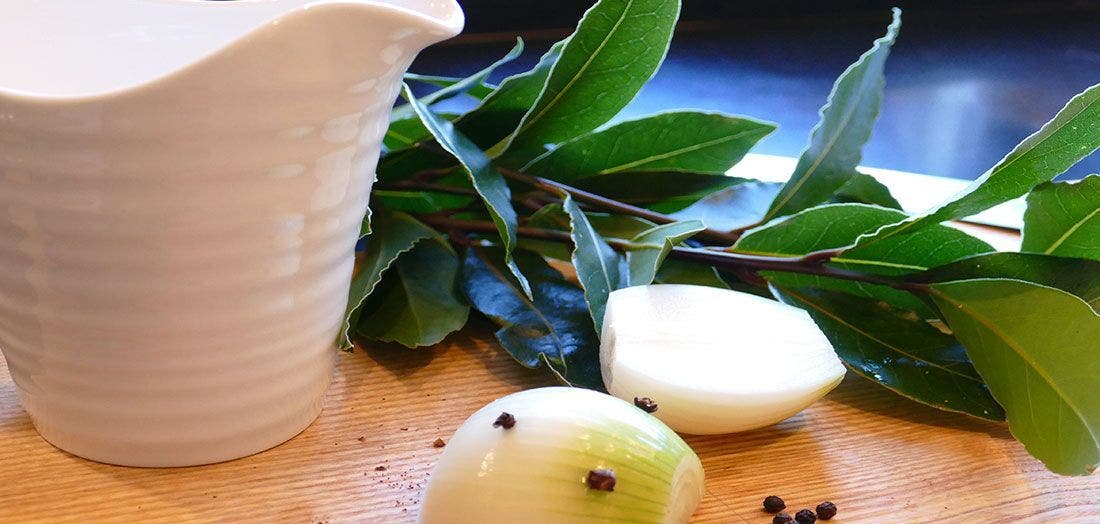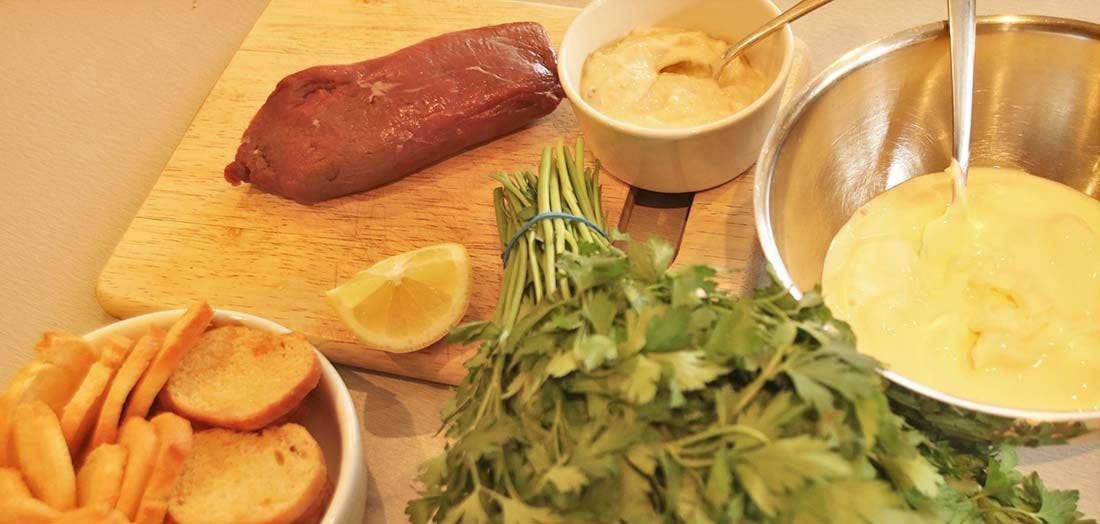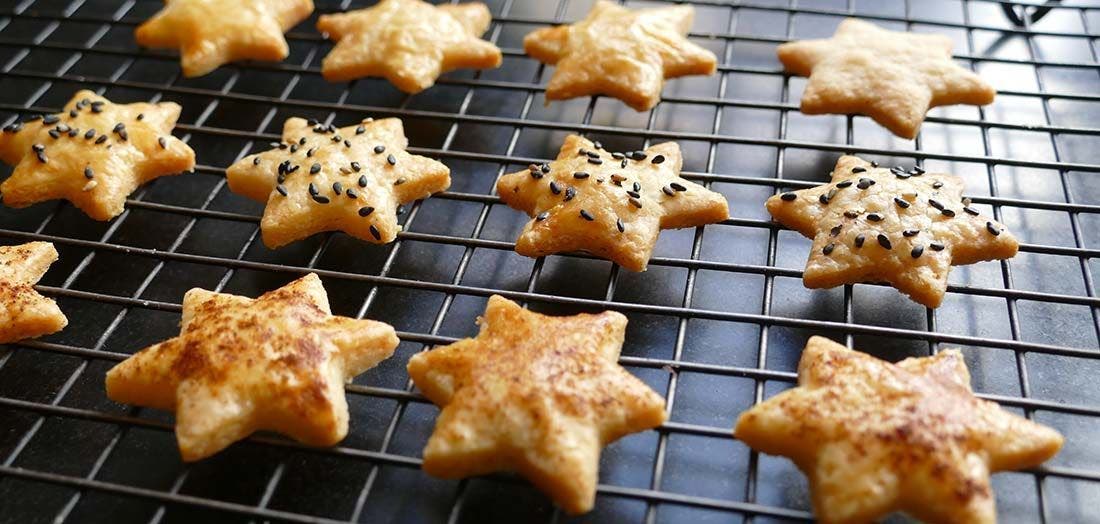There are so many extra elements involved in a classic Christmas lunch (or dinner as it tends to be in our family) it can feel a bit overwhelming. Luckily there is a huge amount you can do in advance to make it all much more manageable.
Preparing The Turkey
You can get the turkey completely ready the day before so that on Christmas Day it only needs to be popped into the oven. I tend to cook the stuffing separately as putting it in the main cavity extends the cooking time, which will only encourage the breasts to dry out. However I do stuff the neck cavity, usually with some really good quality sausage meat, seasoned and mixed with finely chopped chestnuts and parsley (this can be mixed in advance and frozen).To prepare the turkey, roughly chop 2 onions, 2 peeled carrots and a stick of celery and put them in your roasting tin along with some separated but unpeeled garlic cloves, bay leaves and a few sprigs of thyme. Sit the turkey (along with its sausage meat if using) on top and spread softened, seasoned butter all over it. (If you like you could mix some chopped sage through the butter). Then arrange streaky bacon over the butter, overlapping it and making sure you cover both breasts and the legs too. Cover everything loosely with foil, ensuring that it is very well sealed over the edges of the roasting tin. Make sure you have calculated your cooking times based on the weight of the bird (including the sausage meat if using) so you know what time to heat up the oven. Don’t forget to include an hour for resting.
On the day, take the turkey out of the fridge at least an hour before it’s going into the oven. Pre heat the oven to 220°C. Roast for 30 minutes and then turn the oven down to 180°C and cook for another 30-35 minutes per kilo. When it has 30 minutes to go, take the turkey out of the oven and remove the foil and bacon. Pour off the cooking juices into a jug and baste the breast with the buttery liquid which will quickly rise to the top. Add a glass or two of white wine to the tin and put it back in the oven for the final 30 minutes. Check the turkey is cooked by poking the thickest bit of the thigh with a skewer and seeing if the juices are clear. When it’s done, put the turkey on a warm platter and leave to rest for an hour while you finish off everything else.
Bacon and Sausage Rolls
If you can’t find any good quality cocktail sausages just buy some decent chipolatas, pinch them in the middle, twist the two halves around and then cut them in half. Stretch the bacon out with the back of a knife, cut each rasher in half and then wrap around the sausages. You can secure them with cocktail sticks but I usually don’t bother. These can be prepared ages in advance and put in the freezer. They can then be cooked the day (or two) before Christmas (20 minutes at 180°C) and quickly reheated once the turkey has come out of the oven.Top Tips for Stuffing
Stuffing can certainly be made in advance and I find it much easier to cook it separately from the turkey, so it’s not really stuffing at all. To make it really quick to cook and easy to serve, I like to shape the stuffing into individual balls, which can also be made in advance and frozen. When defrosted, the stuffing balls can be cooked just like the bacon and sausage rolls a day or two in advance and then reheated. They will need about 30 minutes at 180°C. If you prefer, you could add them to the turkey roasting tin for the last half hour.As an alternative, you can make your stuffing in a tin, cook the whole thing in advance and freeze it, ready to be defrosted and simply reheated on the day.
Preparing Roast Potatoes and Parsnips
This is my favourite get ahead trick for Christmas. The last thing you want on the big day is lots of pots and pans to clog up the kitchen and require washing up. With this method you can keep the mess and washing up to a minimum by getting all the boiling and straining done well in advance. Sometime early in December, peel the potatoes, cut them to size and put them in a saucepan filled with cold water. Empty all the water out and then replace it with clean water, just enough to cover. Bring them up to a boil, add a big pinch of salt and then simmer for 7 minutes, no more. Strain the potatoes through a colander and leave them to cool. Finally, arrange them on a flat roasting tray so they don’t touch each other and put them in the freezer until frozen. They can then be transferred to a freezer bag. Do exactly the same to the parsnips but parboil them for only 5 minutes before straining, cooling and freezing.
When the turkey comes out of the oven, raise the temperature back up to 220°C and put a shallow roasting tray with plenty of duck fat in it into the oven. Once it has come up to temperature, take the potatoes out of the freezer and put them straight into the roasting tin, basting them with the hot oil. Roast for 45 minutes. When the potatoes go into the oven, put another roasting tin complete with duck fat into the oven and use that for the parsnips which will need 30 minutes. They should both be ready in time to be transferred to a warm serving dish when everything else is done. Ideally you want to serve them as soon as their time in the oven is up; waiting around won’t help their crunch factor!
Making the Perfect Gravy
Gravy made with turkey cooking juices and giblet stock is a wonderful thing but you don’t want to be messing around making it from scratch on the day. The best thing to do is to make a gravy base very well in advance (to be frozen) and the giblet stock when you bring your turkey home from the butcher and then all you have to do on the day is combine those with the cooking juices.In a pan with a little oil, cook finely diced onion, celery and carrot with a whole clove of garlic, sprig of thyme and some salt until it’s all very well softened and then stir in a tablespoon of plain flour. Allow the flour to soak up the fat and cook it off a little before adding a glass of white wine. Leave the liquid completely alone until it starts to simmer and then stir vigorously until you have a smooth paste coating the vegetables. Add chicken stock, stir again, and leave to simmer for about 20 minutes before straining it through a sieve, pressing down on the vegetables to get as much flavour out as possible. I tend to add a splash of Worcester sauce which adds colour as well as a deep savoury flavour and also a spoon of redcurrant jelly. Don’t worry too much about seasoning at this stage; it’s better to adjust it when you’ve got the whole thing together at the end. Your gravy base can then be put in freezer bags or boxes and frozen ready for Christmas.
When you pick up your turkey just before Christmas, you can make giblet stock which will provide the backbone of flavour for your gravy. Put the giblets in a pan with some roughly chopped onion, carrot and celery as well as a sprig of thyme and peeled but whole clove of garlic. A bay leaf would be good too. Cover it all with cold water, bring up to a boil and then simmer for 2 hours. Strain and keep in the fridge until you need it. When it’s well chilled you can scoop off any fat which will have risen to the surface and solidified.
On Christmas Day have the base defrosted, ready in a saucepan along with the giblet stock and when you have poured off the juices before the turkey’s final 30 minutes cooking, you can combine all three elements, spooning any excess fat off the turkey juices first. At this point taste and adjust the seasoning.
Cranberry Sauce
This is another element which can be made well in advance and put in the freezer. There are plenty of recipes for cranberry sauce out there and it’s wonderfully straightforward; simply combine 200g cranberries and 100g light muscovado sugar in a pan with the juice of an orange and a splash of port (wine would do, neither is compulsory) and cook it all together until the fruit softens and bursts; less than 10 minutes. Don’t worry if it still looks a bit liquidy; it will thicken up more as it cools. The only thing to watch out for is that you don’t let it boil until the sugar is completely dissolved. It freezes beautifully.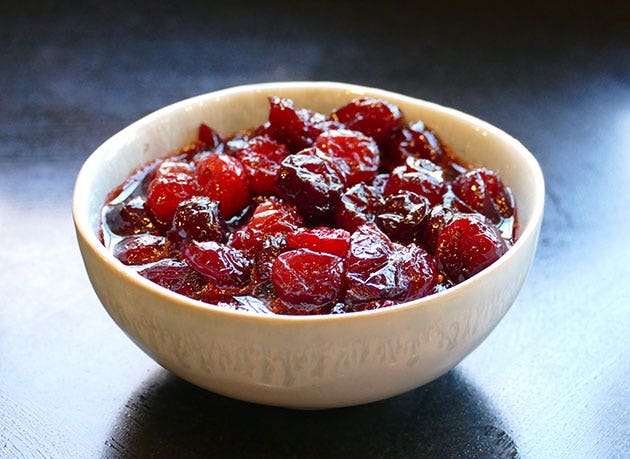
Bread Sauce
And finally, the essential bread sauce. Yet again, this can be made well in advance and frozen so it’s something else to get out of the way before things start getting too busy. Slightly stale white bread is best here so try to remember to buy your loaf a few days before you plan to use the sauce. If you forget, I’ve had great success cutting the crusts off, dividing the bread into large chunks and putting them in the bottom of my Aga-type cooker for a few hours.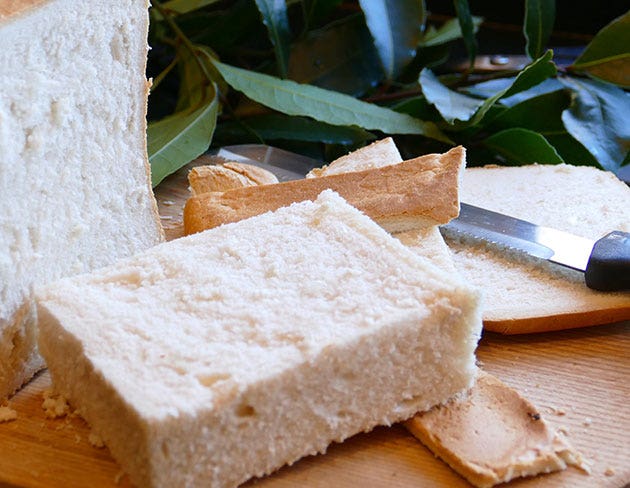
To make the sauce, first combine 250ml whole milk with a bay leaf, some whole peppercorns and half an onion studded with cloves. Bring just to a boil and simmer for 10 minutes. Meanwhile, blitz 110g slightly stale white bread into crumbs in a food processor (or if you prefer you can cut it into cm square chunks). Strain the milk, return it to the pan and, off the heat, whisk in the bread along with a general knob of butter and stir it all until it thickens. Season with salt and some freshly grated nutmeg. At this point you can cool the sauce and put it in the freezer until Christmas. Take it out to defrost on Christmas Eve and when you’re ready for it reheat the sauce with another knob of butter and maybe a dash of double cream.
Summary
So to summarise, here is a list of things you can do in advance and put in your freezer. This can also be used as a check list of what you should remember to take out of the freezer on Christmas Eve to avoid some emergency defrosting on the day!
Well in advance
- Parboil potatoes (cook from frozen)
- Parboil parsnips (cook from frozen)
- Gravy base
- Sausage meat and chestnut stuffing (defrost in time to stuff turkey on Christmas Eve)
- Stuffing balls
- Bacon and sausage rolls
- Cranberry sauce
- Bread sauce
- Prepare turkey with vegetables, butter, bacon and sausage meat stuffing
- Take things out of the freezer to defrost overnight
The nightmare before Christmas has an all-too-familiar resonance for many families, but a nightmare in the kitchen on the big day is totally avoidable if you follow the advice from our celebrity cook, Annie Assheton, who is here to ease you through the whole process of planning the perfect Christmas dinner.
There are so many extra elements involved in a classic Christmas lunch (or dinner as it tends to be in our family) it can feel a bit overwhelming. Luckily there is a huge amount you can do in advance to make it all much more manageable.
Christmas Dinner Tips
Preparing The Turkey
You can get the turkey completely ready the day before so that on Christmas Day it only needs to be popped into the oven. I tend to cook the stuffing separately as putting it in the main cavity extends the cooking time, which will only encourage the breasts to dry out. However I do stuff the neck cavity, usually with some really good quality sausage meat, seasoned and mixed with finely chopped chestnuts and parsley (this can be mixed in advance and frozen).
To prepare the turkey, roughly chop 2 onions, 2 peeled carrots and a stick of celery and put them in your roasting tin along with some separated but unpeeled garlic cloves, bay leaves and a few sprigs of thyme. Sit the turkey (along with its sausage meat if using) on top and spread softened, seasoned butter all over it. (If you like you could mix some chopped sage through the butter). Then arrange streaky bacon over the butter, overlapping it and making sure you cover both breasts and the legs too. Cover everything loosely with foil, ensuring that it is very well sealed over the edges of the roasting tin. Make sure you have calculated your cooking times based on the weight of the bird (including the sausage meat if using) so you know what time to heat up the oven. Don’t forget to include an hour for resting.
On the day, take the turkey out of the fridge at least an hour before it’s going into the oven. Pre heat the oven to 220°C. Roast for 30 minutes and then turn the oven down to 180°C and cook for another 30-35 minutes per kilo. When it has 30 minutes to go, take the turkey out of the oven and remove the foil and bacon. Pour off the cooking juices into a jug and baste the breast with the buttery liquid which will quickly rise to the top. Add a glass or two of white wine to the tin and put it back in the oven for the final 30 minutes. Check the turkey is cooked by poking the thickest bit of the thigh with a skewer and seeing if the juices are clear. When it’s done, put the turkey on a warm platter and leave to rest for an hour while you finish off everything else.
Bacon and Sausage Rolls
If you can’t find any good quality cocktail sausages just buy some decent chipolatas, pinch them in the middle, twist the two halves around and then cut them in half. Stretch the bacon out with the back of a knife, cut each rasher in half and then wrap around the sausages. You can secure them with cocktail sticks but I usually don’t bother. These can be prepared ages in advance and put in the freezer. They can then be cooked the day (or two) before Christmas (20 minutes at 180°C) and quickly reheated once the turkey has come out of the oven.
Top Tips for Stuffing
Stuffing can certainly be made in advance and I find it much easier to cook it separately from the turkey, so it’s not really stuffing at all. To make it really quick to cook and easy to serve, I like to shape the stuffing into individual balls, which can also be made in advance and frozen. When defrosted, the stuffing balls can be cooked just like the bacon and sausage rolls a day or two in advance and then reheated. They will need about 30 minutes at 180°C. If you prefer, you could add them to the turkey roasting tin for the last half hour.
As an alternative, you can make your stuffing in a tin, cook the whole thing in advance and freeze it, ready to be defrosted and simply reheated on the day.
Preparing Roast Potatoes and Parsnips
This is my favourite get ahead trick for Christmas. The last thing you want on the big day is lots of pots and pans to clog up the kitchen and require washing up. With this method you can keep the mess and washing up to a minimum by getting all the boiling and straining done well in advance. Sometime early in December, peel the potatoes, cut them to size and put them in a saucepan filled with cold water. Empty all the water out and then replace it with clean water, just enough to cover. Bring them up to a boil, add a big pinch of salt and then simmer for 7 minutes, no more. Strain the potatoes through a colander and leave them to cool. Finally, arrange them on a flat roasting tray so they don’t touch each other and put them in the freezer until frozen. They can then be transferred to a freezer bag. Do exactly the same to the parsnips but parboil them for only 5 minutes before straining, cooling and freezing.
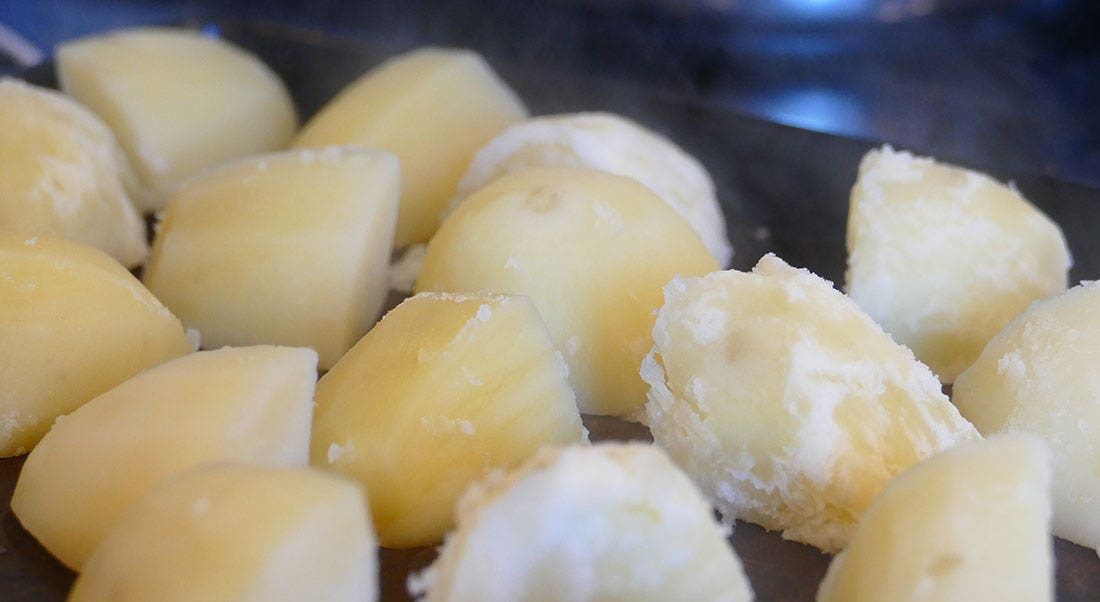

When the turkey comes out of the oven, raise the temperature back up to 220°C and put a shallow roasting tray with plenty of duck fat in it into the oven. Once it has come up to temperature, take the potatoes out of the freezer and put them straight into the roasting tin, basting them with the hot oil. Roast for 45 minutes. When the potatoes go into the oven, put another roasting tin complete with duck fat into the oven and use that for the parsnips which will need 30 minutes. They should both be ready in time to be transferred to a warm serving dish when everything else is done. Ideally you want to serve them as soon as their time in the oven is up; waiting around won’t help their crunch factor!
Making the Perfect Gravy
Gravy made with turkey cooking juices and giblet stock is a wonderful thing but you don’t want to be messing around making it from scratch on the day. The best thing to do is to make a gravy base very well in advance (to be frozen) and the giblet stock when you bring your turkey home from the butcher and then all you have to do on the day is combine those with the cooking juices.
In a pan with a little oil, cook finely diced onion, celery and carrot with a whole clove of garlic, sprig of thyme and some salt until it’s all very well softened and then stir in a tablespoon of plain flour. Allow the flour to soak up the fat and cook it off a little before adding a glass of white wine. Leave the liquid completely alone until it starts to simmer and then stir vigorously until you have a smooth paste coating the vegetables. Add chicken stock, stir again, and leave to simmer for about 20 minutes before straining it through a sieve, pressing down on the vegetables to get as much flavour out as possible. I tend to add a splash of Worcester sauce which adds colour as well as a deep savoury flavour and also a spoon of redcurrant jelly. Don’t worry too much about seasoning at this stage; it’s better to adjust it when you’ve got the whole thing together at the end. Your gravy base can then be put in freezer bags or boxes and frozen ready for Christmas.
When you pick up your turkey just before Christmas, you can make giblet stock which will provide the backbone of flavour for your gravy. Put the giblets in a pan with some roughly chopped onion, carrot and celery as well as a sprig of thyme and peeled but whole clove of garlic. A bay leaf would be good too. Cover it all with cold water, bring up to a boil and then simmer for 2 hours. Strain and keep in the fridge until you need it. When it’s well chilled you can scoop off any fat which will have risen to the surface and solidified.
On Christmas Day have the base defrosted, ready in a saucepan along with the giblet stock and when you have poured off the juices before the turkey’s final 30 minutes cooking, you can combine all three elements, spooning any excess fat off the turkey juices first. At this point taste and adjust the seasoning.
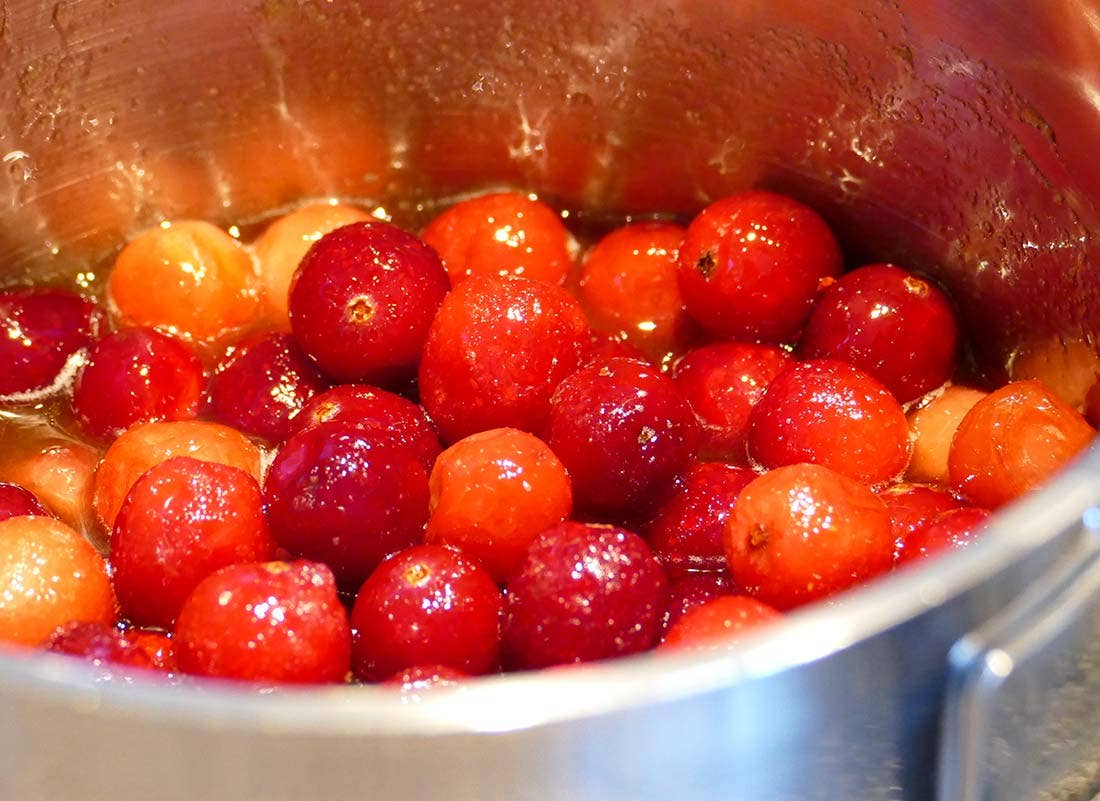

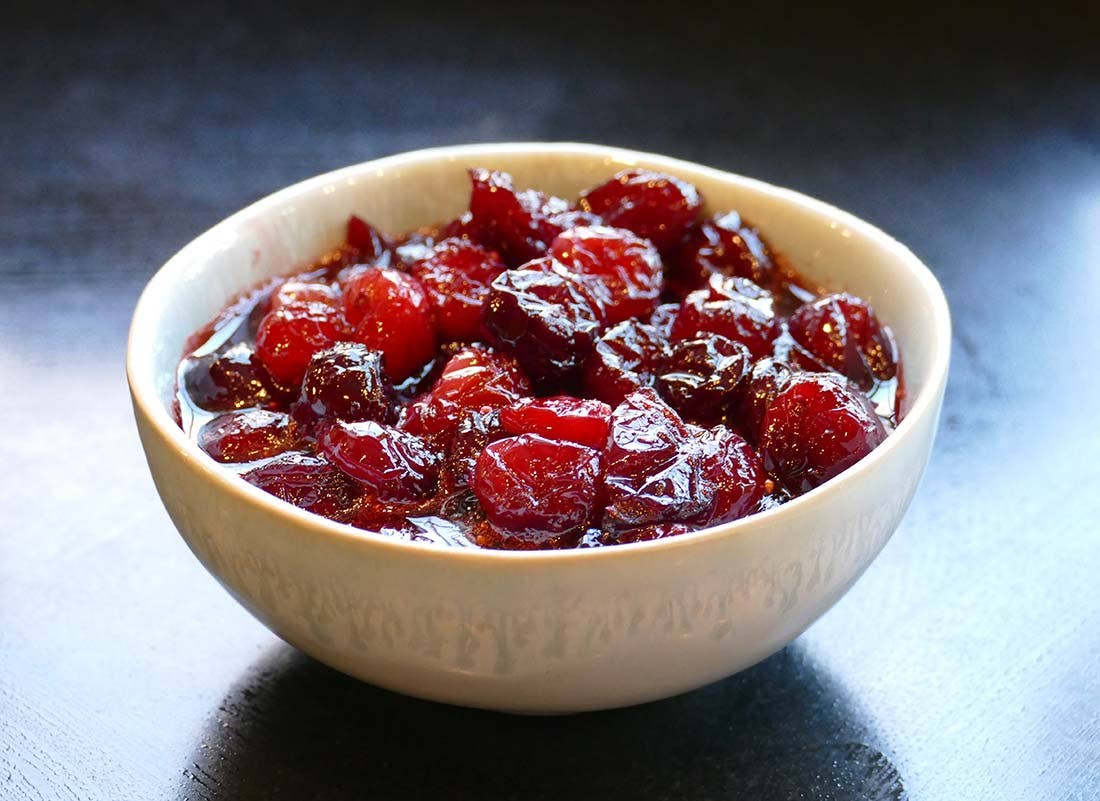

Cranberry Sauce
This is another element which can be made well in advance and put in the freezer. There are plenty of recipes for cranberry sauce out there and it’s wonderfully straightforward; simply combine 200g cranberries and 100g light muscovado sugar in a pan with the juice of an orange and a splash of port (wine would do, neither is compulsory) and cook it all together until the fruit softens and bursts; less than 10 minutes. Don’t worry if it still looks a bit liquidy; it will thicken up more as it cools. The only thing to watch out for is that you don’t let it boil until the sugar is completely dissolved. It freezes beautifully.
Bread Sauce
And finally, the essential bread sauce. Yet again, this can be made well in advance and frozen so it’s something else to get out of the way before things start getting too busy. Slightly stale white bread is best here so try to remember to buy your loaf a few days before you plan to use the sauce. If you forget, I’ve had great success cutting the crusts off, dividing the bread into large chunks and putting them in the bottom of my Aga-type cooker for a few hours.
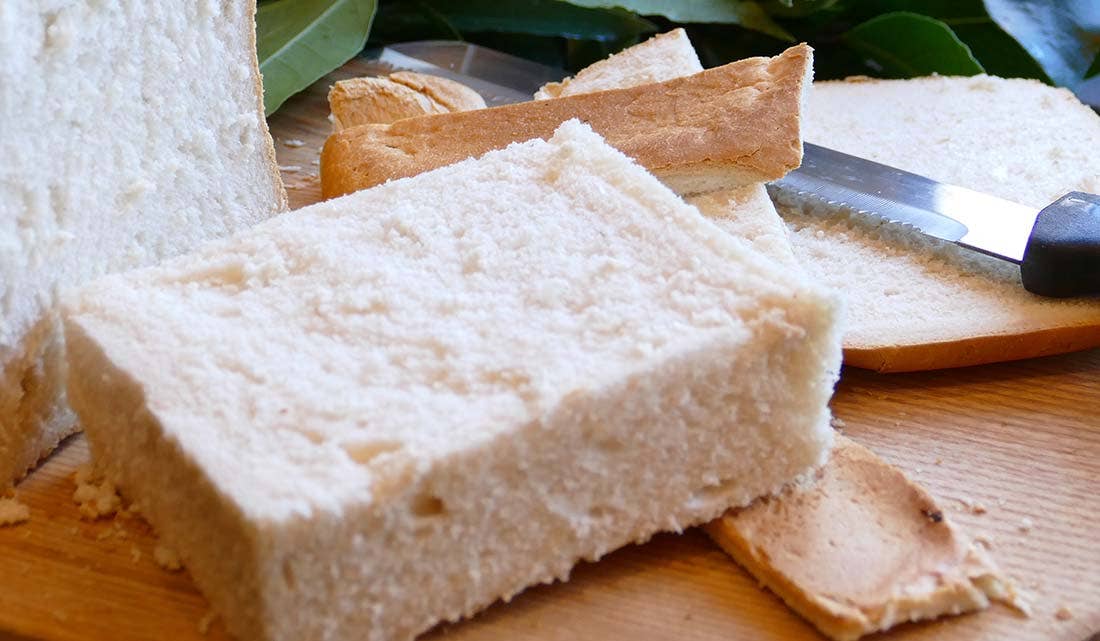

To make the sauce, first combine 250ml whole milk with a bay leaf, some whole peppercorns and half an onion studded with cloves. Bring just to a boil and simmer for 10 minutes. Meanwhile, blitz 110g slightly stale white bread into crumbs in a food processor (or if you prefer you can cut it into cm square chunks). Strain the milk, return it to the pan and, off the heat, whisk in the bread along with a general knob of butter and stir it all until it thickens. Season with salt and some freshly grated nutmeg. At this point you can cool the sauce and put it in the freezer until Christmas. Take it out to defrost on Christmas Eve and when you’re ready for it reheat the sauce with another knob of butter and maybe a dash of double cream.
Christmas Dinner Checklist
So to summarise, here is a list of things you can do in advance and put in your freezer. This can also be used as a check list of what you should remember to take out of the freezer on Christmas Eve to avoid some emergency defrosting on the day!
Well in advance
- Parboil potatoes (cook from frozen)
- Parboil parsnips (cook from frozen)
- Gravy base
- Sausage meat and chestnut stuffing (defrost in time to stuff turkey on Christmas Eve)
- Stuffing balls
- Bacon and sausage rolls
- Cranberry sauce
- Bread sauce
On Christmas Eve
- Prepare turkey with vegetables, butter, bacon and sausage meat stuffing
- Take things out of the freezer to defrost overnight


